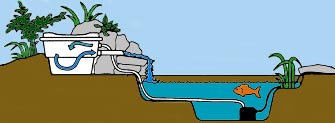A variety of filters is available. Some primarily protect the pump and fountainheads from clogging with debris. Other, larger filters, will aid in keeping the water clear. To filter adequately, pumps should have Gallons Per Hour (GPH) rating equal to about half of the pool volume. The addition of waterfalls, fountainheads and filters will reduce GPH.
A plant filter works with nature. It is easy to construct and requires little maintenance. No more cleaning filter media – let the bacteria and plants do all the work!
Just connect a small shallow pond, approximately 10% of the surface area of the main pond, to the main pond. Increase the size up to 25% if a large population of fish or Koi is anticipated.
Add bog plants in containers of soil and/or pea gravel and floating plants. Water Hyacinths, Water Cress, Water Celery are but a few choices that thrive in plant filters. Circulate the water slowly throughout the entire filter pond to the main pond. Enjoy clear water and luxuriant plant growth.
Plant filter ponds may be constructed from liner, preformed containers or preformed ponds with spillways. All available at Moore Water Gardens.
Mechanical filters are used in front of or before the pump to prevent floating debris in the water from entering and clogging the pump and fountainheads. Usually comprised of foam and/or screen, they may sometimes be found in the first layer of biological filters as well.
It is recommended that all pumps be protected by some sort of mechanical filter to prolong their life.
(see Filters & UV Clarifiers)
Biological filtration is a proven method for maintaining good water quality for fish and plants. These filters include high capacity media providing large surface area for colonies of “good” bacteria to thrive on waste by-products of fish and plants. Biological filtration does not produce solid waste so little to no maintenance is required once the filtration begins. To filter adequately, pumps should recirculate the pond volume through the biofilter once every two hours.
NOTE: A bio-filter is designed for continuous duty. If it is left idle for more than a half-hour, the bacteria will die and emit toxins back into your pond. The entire process of colonization will have to start over, which could take several weeks. Bacteria starters may be added to expedite this process.
(see Pond Water Treatments)
When choosing a biofilter consider the following factors which require more filtration:
- Koi eat more and produce more waste than Goldfish.
- A large fish population will increase waste pollution.
- Shallow ponds will require more filtration.
- Exposure to full sun also encourages algae growth.

Green water is caused by the growth of tiny single cells of algae. As water passes through the UV clarifier, the single celled algae are clumped together. The filter can now remove these larger algae particles. UV Clarifiers can be added to new or existing filter systems. (see Filters & Clarifiers)





